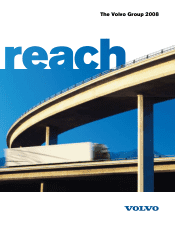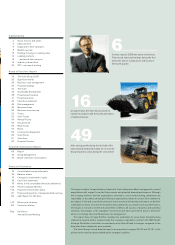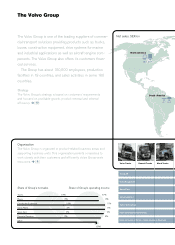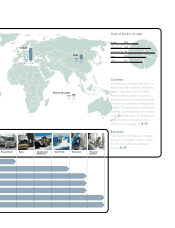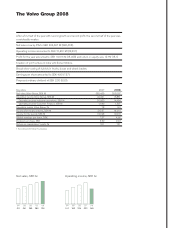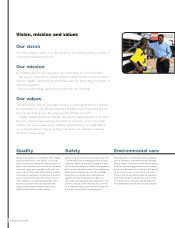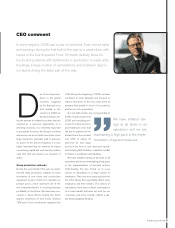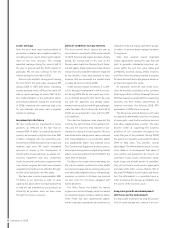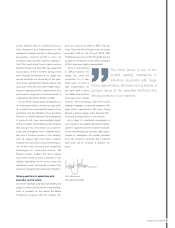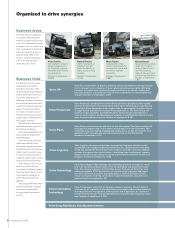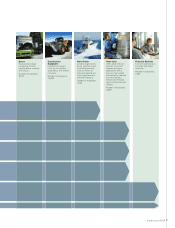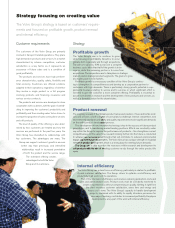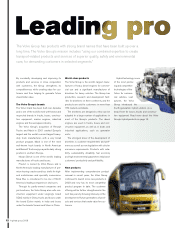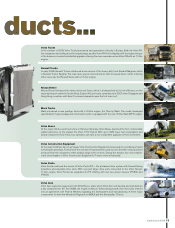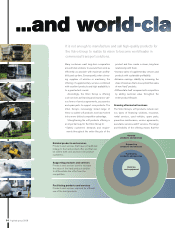Volvo 2008 Annual Report Download - page 8
Download and view the complete annual report
Please find page 8 of the 2008 Volvo annual report below. You can navigate through the pages in the report by either clicking on the pages listed below, or by using the keyword search tool below to find specific information within the annual report.
Lower earnings
Over the short term, rapid implementation of
production cutbacks has a negative impact on
operating income, due to a time-lag for adjust-
ment of the cost structure. This strongly
impacted earnings during the second half of
the year in general and the fourth quarter in
particular. We will also continue to feel the
effects during the fi rst half of 2009.
Driven by the market’s strong growth during
the fi rst half of the year, sales increased 6%
during 2008 to SEK 304 billion. Operating
income declined nearly 30%, but we were still
able to report earnings of nearly SEK 16 bil-
lion. Underutilization in the production plants
and reduced deliveries during the second half
of 2008, combined with continued high costs
for raw materials and parts, had a negative
impact on earnings.
Investments in the future
We also continued our investments in future
products, as refl ected by the fact that we
invested SEK 14 billion in research and devel-
opment, an increase by slightly more than SEK
3 billion compared with the preceding year.
Investments in R&D are planned to remain at a
relatively high level. We invest substantial
amounts of money in the development of
hybrids within trucks and buses as well as con-
struction equipment and new, competitive
trucks, buses and construction equipment with
new, cleaner engines that meet new emission
regulations that will become effective through-
out the world during the next few years.
We have also invested approximately SEK
10 billion in our factories in order to raise
capacity but above all to increase productivity
so that we can manufacture our products as
effi ciently as possible when we have come
through the current recession.
Diffi cult conditions in many markets
The truck market, which started the year at
record levels in most parts of the world outside
of North America and Japan, declined sharply
during the second half of the year in the
Group’s main markets in Europe, North Amer-
ica and Japan. Toward year-end, it was obvious
that all of our truck markets had been impacted
by the decline. I have been pleased to note,
however, that we increased our market share
in nearly all markets during 2008.
Under present market conditions, it is diffi -
cult to forecast development in the truck mar-
ket during 2009. We do not expect any recov-
ery in demand during the fi rst half of the year,
but with the approved and already imple-
mented internal actions that will gradually gen-
erate favorable effects during the fi rst half of
2009, we are prepared to cope with the diffi -
cult conditions.
Construction Equipment was impacted the
most by the rapid decline in the global econ-
omy, and the business area reported a sub-
stantial loss during the fourth quarter. The loss
was attributed to sharply lower sales combined
with underutilization in our production plants
and signifi cantly higher raw material costs.
The Construction Equipment business area is
now implementing measures that will gradually
adjust costs during the fi rst half of 2009 to the
lower level of demand.
For Buses, the coach market was weak, but
the city bus market continued to show stable
development supported by growing interest in
environmentally adapted vehicles, with particular
emphasis on hybrids. In October, we received
our fi rst order for city buses equipped with
hybrid drivelines.
For Volvo Penta, the market for marine
engines has declined sharply, while the market
for industrial engines remains relatively stable.
Volvo Penta has also implemented adjust-
ments in business operations and continues to
expand its industrial engine operations as part
of efforts to achieve better balance between
its segments.
Volvo Aero reached several important
engine agreements during the year that will
start to generate substantial long-term rev-
enues within the next few years. Sales and
profi tability declined during 2008, however,
and Volvo Aero has already started to prepare
for lower demand due to the general decline in
air travel throughout the world.
As expected, write-offs and credit provi-
sions for doubtful receivables in the customer
fi nancing portfolio of Volvo Financial Services
(VFS) increased in parallel with the weakening
economy, but they remain, nevertheless, at
relatively low levels. For full-year 2008, VFS
generated a 12.6% return on equity.
The Group has worked during recent years
to expand its aftermarket business consisting
of spare parts, used trucks, workshop services
and other supplementary services. We have
become better at supporting the business
activities of our customers throughout the
entire lifecycle of the products. During 2008,
this part of our operations accounted for about
26% of total sales. This provides several
advantages. The aftermarket business is much
more stable in its development than sales of
new vehicles and equipment. As long as our
customers’ trucks, buses, construction equip-
ment, boats and aircraft remain in operation,
they will continue to need service, spare parts
and many of the other services that we offer in
this area. Profi tability is also higher, and there-
fore the aftermarket is a prioritized area in
order to improve the Group’s profi tability over
the course of the business cycle.
Long-term growth and development
with focus on the environment
It is impossible to predict how long the present
level of weak demand will continue. I am con-
A global group 2008
4

